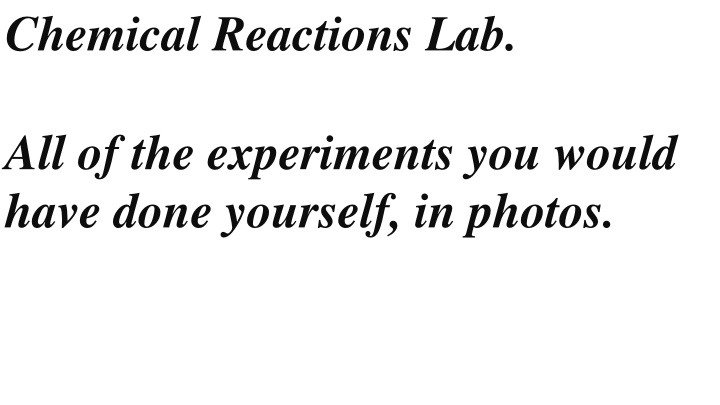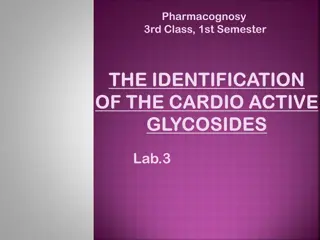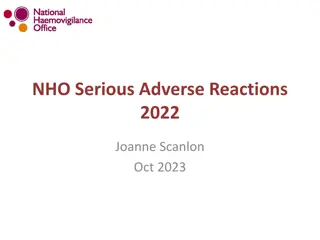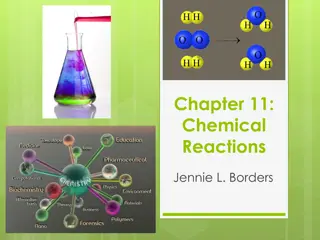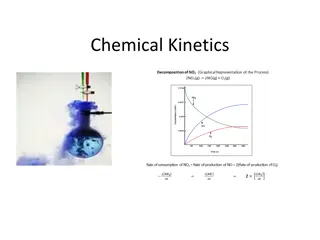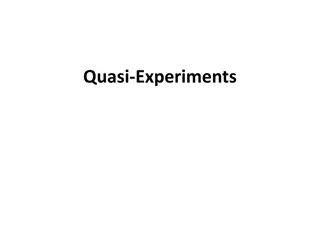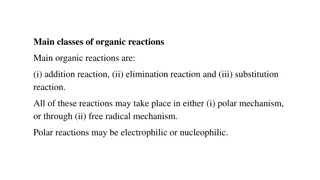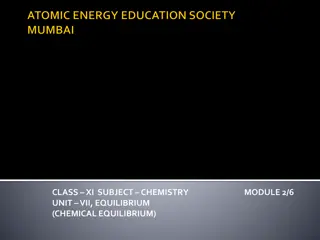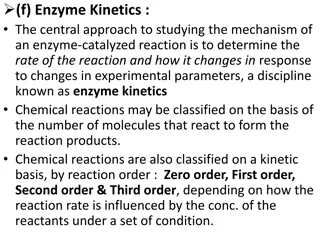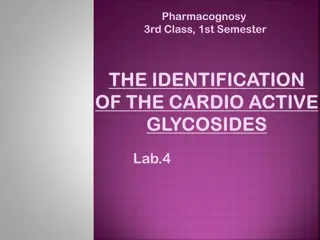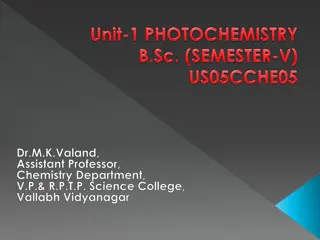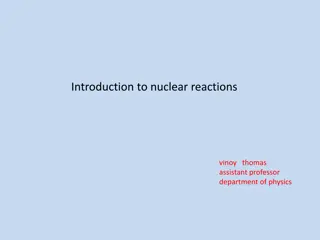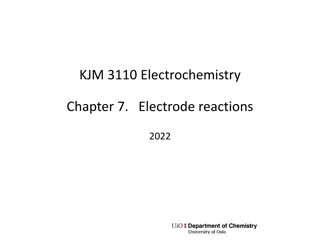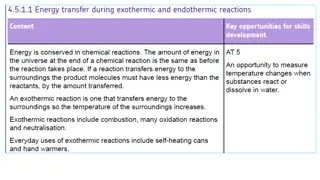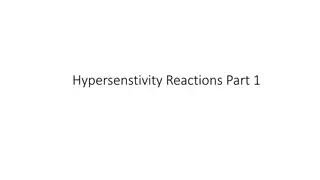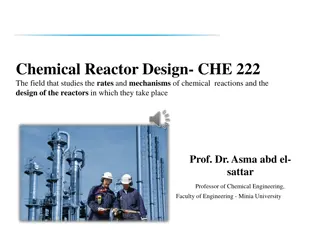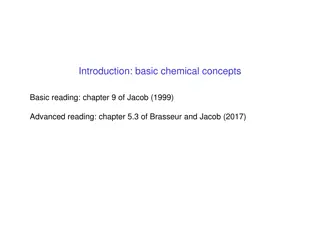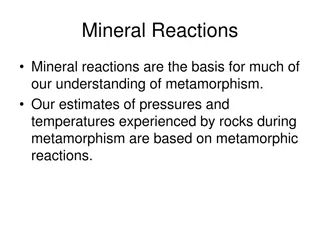Chemical Reactions Lab Experiments
Photos and detailed explanations of chemical reactions lab experiments including synthesis, decomposition, single replacement, double replacement, and combustion reactions. Learn about indicators of chemical reactions and gas tests for carbon dioxide, oxygen, and hydrogen. Dive into 20 chemical reactions, write balanced and word equations, and witness the decomposition of water with a Hoffmann apparatus.
Download Presentation

Please find below an Image/Link to download the presentation.
The content on the website is provided AS IS for your information and personal use only. It may not be sold, licensed, or shared on other websites without obtaining consent from the author.If you encounter any issues during the download, it is possible that the publisher has removed the file from their server.
You are allowed to download the files provided on this website for personal or commercial use, subject to the condition that they are used lawfully. All files are the property of their respective owners.
The content on the website is provided AS IS for your information and personal use only. It may not be sold, licensed, or shared on other websites without obtaining consent from the author.
E N D
Presentation Transcript
Chemical Reactions Lab. All of the experiments you would have done yourself, in photos.
There are five kinds of chemical reactions (so far) 1. Synthesis (sometimes called combination) 2. Decomposition (opposite of synthesis) 3. Single Replacement 4. Double Replacement 5. Combustion
TOPIC-B are the indicators that a chemical reaction PROBABLY happened. If you see these, look carefully to see what might have really happened. T temperature changes O odor changes P precipitate falls out of solution I these are SPONTANEOUSLY irreversible (all chemical reactions can be reversed) C color change B bubbles of a new gas form
What happens? Gas Test Carbon dioxide Flaming splint Oxygen Glowing splint Hydrogen Flaming splint There is a link to click in experiment 2 that shows the three tests for these 3 gases. Patience, you re nearly there!
What happens? Gas Test Flame goes out Carbon dioxide Flaming splint Oxygen Glowing splint Wood reignites Hydrogen Flaming splint The famous toot
In this lab there are 20 chemical reactions (some of them are physical changes and not reactions, observe carefully). For each one You must write a BALANCED CHEMICAL EQUATION; You must write a WORD EQUATION; and You can t leave any BLANKS.
Reaction #1 The Decomposition of Water with a Hoffmann Apparatus This cool machine breaks water into 2 gases: H2 and O2. Electricity from the wall is ALTERNATING CURRENT, and the green box changes it to DIRECT CURRENT (like a battery). Direct current runs through the water, which also has some acid in it (that allows the water to conduct electricity). Pure water cannot conduct electricity.
This is the electrode on the left, where the hydrogen gas forms. See the bubbles popping off the metal and going UP the tube?
This is the electrode on the right, where the oxygen gas forms. See the bubbles popping off the metal and going UP the tube?
After 40 seconds, the difference of gas volumes is even more pronounced. After 20 seconds, the difference of gas volumes is obvious, with hydrogen on the left, oxygen at right.
Reaction #2 The Synthesis of Water Here, some H2(G) combines with O2(G) from the air to make water. There is no way to photograph this, but I did make a video of how the Hoffmann Apparatus works, and I did the tests for all three gases. Most fun is hydrogen, then the test for oxygen gas, and lastly the test for carbon dioxide gas. Click here for the video.
Reaction #3 The Combustion of Wood A splint of wood near the Bunsen burner, then wood burning. You have seen wood burn; it is a real chemical reaction. Wood is an oxygenated hydrocarbon .
Reaction #4 Making some Copper Oxide (which one?) Heat up the copper wire in the Bunsen burner, it gets so hot that it gets excited enough to combine with oxygen in the air. Your job is to determine which one forms, and which formula it is. Copper turns black , which is the Copper (II) oxide.
Reaction #5 Breaking down copper (II) carbonate with heat The compound is in a test tube, held up by a test tube clamp to the ring stand. The heat is sufficient to decompose this compound. The compound is green, but when it decomposes, the product is black. The other product is an invisible gas which puts out the flame (what gas does that?)
Reaction #5 Breaking down copper (II) carbonate with heat The product in the tube is now all black. What do you think that solid product might be? (duh!)
Reaction #6 Magnesium combines with oxygen (rapidly) to show clearly a big change from metal to dust. 22.56 g is the start mass (Mg and the cup). I heated it with a Bunsen burner in a big way. The metal oxidized.
Reaction #6 Magnesium combines with oxygen (rapidly) to show clearly a big change from metal to dust. 22.56 g is the start mass but the end mass is higher, 22.64 g!!! What about the Law of Conservation of Mass? What s up here?
Reaction #7 Sodium Phosphate + Silver Nitrate Solutions Two solutions, both clear to start, mixed together, and a chemical reaction happens. Notice the PRECIPTITATE that forms. The precipitate shown on white, and black backgrounds.
Reaction #8 Sodium Hydroxide + Copper (II) Sulfate Solutions One clear, one blue solution to start, mixed together, and a chemical reaction happens. Notice the PRECIPTITATE that forms. Precipitate shown on white and black backgrounds.
Reaction #9 Sodium Hydroxide + Cobalt (II) Nitrate Solutions One red, and one clear solution to start. When mixed together, a chemical reaction happens. Notice the purple colored PRECIPTITATE that forms. See how it s not just a purple solution, but there are spots of purple floating in the clear solution?
Reaction #10 Rubidium Chloride + Ammonium Nitrate Solutions Two clear solutions to start, mixed together, and a chemical reaction happens. Notice DID A PRECIPTITATE form? I added more RbBr(AQ) to the right side, no changes noticed
Reaction #11 Magnesium + Hydrochloric Acid Solution Magnesium goes into clear solution (acid) has vigorous reaction. Acid it test tube, magnesium metal on table, beaker to hold it all. Reaction goes wild, I catch the gas in upper test tube. It s getting hot!
Reaction #11 Magnesium + Hydrochloric Acid Solution Too hot! The test for hydrogen gas worked, on a short video that I shot it was too quiet to catch the toot . The toot is like the FIREBALL on the first day, but on a smaller scale. Toot, not boom! The test requires you hold a lit stick of wood underneath the upside-down tube of hydrogen gas. It is okay to keep it open, the low-density gas stays in the tube, it can t pour out. The toot is usually quite loud! The toot is the exothermic part of the synthesis of water from hydrogen gas and oxygen in the air.
Reaction #12 Iron + Sodium Chloride Solution Before and after, an iron nail goes into a clear solution. The solution stays clear, no changes noticed to the nail either.
Reaction #14 Iron + Copper II Sulfate Solution Before and after, an iron nail goes into the blue solution. The nail comes out red colored, which can be scraped off with a fingernail. The solution is noticeably less blue than it was (?)! The nail is covered in reddish stuff, which of course is COPPER from the SR reaction that happened here.
Reaction #15 Methane gas burns (combusts) Before and after, a Bunsen burner with igniter, then, a lit Bunsen burner, methane gas burns in the oxygen in the air. Everything here is a gas: the reactants are gases, and products are gases too. These gases are all invisible to our eyes, but REAL.
Reaction #16 Burning of a candle Candle on a watch glass on the scale, the candle burning in oxygen in the air, the candle on scale after about 16 minutes. Where did that 1.28 grams of the candle disappear to???
Reaction #17 Ethanol alcohol burns The alcohol is burned ON a salt called lithium chloride. The salt only gets hot, the electrons in the salt get excited by this input of heat energy. The electrons move to the excited state. These electrons return to the ground state, emitting that lavender color in the flame. Using the lithium chloride is just for fun, and to remind you about spectra. The burning of ethanol is kind of boring , just a blue flame, like Bunsen burner gas.
Reaction #18 Butane gas combusts We have butane gas in the clicker lighter . It burns like methane does, but it has a different formula.
Reaction #19 putting potassium nitrate salt into water. This is a white crystal solid ionic salt, which is added to water, forming a solution. Water starts at 19.5 C. After adding the salt, the temperature changes to 16.8 C.
Reaction #20 Aluminum added to potassium chloride solution Before and after: an aluminum nail is put into a clear potassium chloride solution. The solution stayed clear, the nail got wet, no changes to either are visible.
